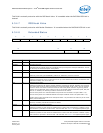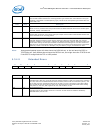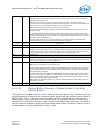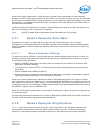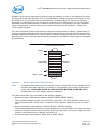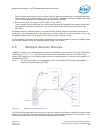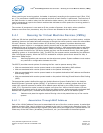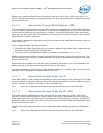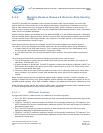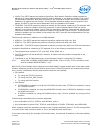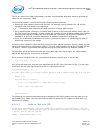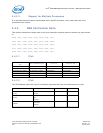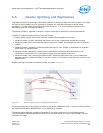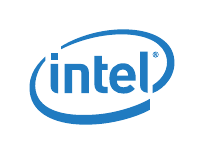
Queuing for Virtual Machine Devices (VMDq) — Intel
®
82575EB Gigabit Ethernet Controller
324632-003 Intel
®
82575EB Gigabit Ethernet Controller
Revision: 2.1 Software Developer’s Manual and EEPROM Guide
January 2011 121
Software can program different values to the MAC filters (any bits in RAH or RAL) at any time. The
82575 responds to the change on a packet boundary but does not guarantee the change to take place
at some precise time.
5.4.1.2 Association Through MAC Address + RSS
This mode combines classification through a MAC address and load balancing via RSS. MAC addressing
is used to classify packets to two pools (where a pool can be associated with a VM). RSS is then used
for each pool to determine the exact queue or processor. A single RSS Redirection Table serves both
pools; with the first half of each entry dedicated to pool 0 and the second half to pool 1. Note that the
same RSS key is used for both pools.
This scheme is targeted for VMDq use as well as future uses such as classification between a LAN pool
and an iSCSI pool.
This two-stage procedure operates as follows:
• The MSB of the QSEL field (QSEL[19]) in the Receive Address High register (RAH) matched by the
Destination Address determines the target pool.
• The index into the RSS Redirection Table is computed as in described in Section 5.4.2.
Software might program different values to the MAC filters (any bits in RAH or RAL) at any time. The
82575 responds to the change on a packet boundary but does not guarantee the change to take place
at some precise time.
Packets that do not match any of the MAC filters (broadcast, promiscuous, etc.) are forwarded to the
default pool and are further classified by the RSS rules for that queue.
A packet forwarded to a queue (either by MAC address matching or by default), that cannot receive an
RSS hash value is assigned to the default queue of this pool.
5.4.1.3 Association through VLAN tag ID
When MRCQ.MRQE = 100b, packets are forwarded to a queue according to their VLAN tag ID. The VLAN
tag of the packet is used as an index to a table that indicates the queue to which the packet should be
routed. The table is created by the VFQA1 (msb) and VFQA0 (lsb).
Note: Note: The VLAN tags that should be received should also be set in the VFTA table.
5.4.1.4 Association through VLAN tag ID +RSS
This mode combines classification through VLAN tag ID and load balancing via RSS. VLAN tag ID
filtering is used to classify packets to 2 pools (where a pool may be associated with a VM) using the
VFQA1 table. RSS is then used for each pool to determine the exact queue or processor. A single RSS
Redirection Table serves both pools; with the first half of each Indirection Table entry dedicated to pool
0 and the second half to pool 1.
The RSS redirection method is similar to the method used when associating queues by MAC address
+RSS.
Note: Note: The VLAN tags that should be received should also be set in the VFTA table



